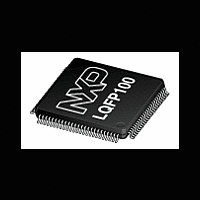LPC2361_62 NXP Semiconductors, LPC2361_62 Datasheet - Page 29

LPC2361_62
Manufacturer Part Number
LPC2361_62
Description
The LPC2361/2362 microcontrollers are based on a 16-bit/32-bit ARM7TDMI-S CPU with real-time emulation that combines the microcontroller with up to 128 kB of embedded high-speed flash memory
Manufacturer
NXP Semiconductors
Datasheet
1.LPC2361_62.pdf
(64 pages)
NXP Semiconductors
LPC2361_62
Product data sheet
7.23.4.1 Idle mode
7.23.4.2 Sleep mode
7.23.4.3 Power-down mode
7.23.4.4 Deep power-down mode
In Idle mode, execution of instructions is suspended until either a Reset or interrupt
occurs. Peripheral functions continue operation during Idle mode and may generate
interrupts to cause the processor to resume execution. Idle mode eliminates dynamic
power used by the processor itself, memory systems and related controllers, and internal
buses.
In Sleep mode, the oscillator is shut down and the chip receives no internal clocks. The
processor state and registers, peripheral registers, and internal SRAM values are
preserved throughout Sleep mode and the logic levels of chip pins remain static. The
output of the IRC is disabled but the IRC is not powered down for a fast wake-up later. The
32 kHz RTC oscillator is not stopped because the RTC interrupts may be used as the
wake-up source. The PLL is automatically turned off and disconnected. The CCLK and
USB clock dividers automatically get reset to zero.
The Sleep mode can be terminated and normal operation resumed by either a Reset or
certain specific interrupts that are able to function without clocks. Since all dynamic
operation of the chip is suspended, Sleep mode reduces chip power consumption to a
very low value. The flash memory is left on in Sleep mode, allowing a very quick wake-up.
On the wake-up of Sleep mode, if the IRC was used before entering Sleep mode, the
code execution and peripherals activities will resume after 4 cycles expire. If the main
external oscillator was used, the code execution will resume when 4096 cycles expire.
The customers need to reconfigure the PLL and clock dividers accordingly.
Power-down mode does everything that Sleep mode does, but also turns off the IRC
oscillator and the flash memory. This saves more power, but requires waiting for
resumption of flash operation before execution of code or data access in the flash memory
can be accomplished.
On the wake-up of Power-down mode, if the IRC was used before entering Power-down
mode, it will take IRC 60 s to start-up. After this 4 IRC cycles will expire before the code
execution can then be resumed if the code was running from SRAM. In the meantime, the
flash wake-up timer then counts 4 MHz IRC clock cycles to make the 100 s flash start-up
time. When it times out, access to the flash will be allowed. The customers need to
reconfigure the PLL and clock dividers accordingly.
Deep power-down mode is similar to the Power-down mode, but now the on-chip
regulator that supplies power to the internal logic is also shut off. This produces the lowest
possible power consumption without removing power from the entire chip. Since the Deep
power-down mode shuts down the on-chip logic power supply, there is no register or
memory retention, and resumption of operation involves the same activities as a full chip
reset.
If power is supplied to the LPC2361/2362 during Deep power-down mode, wake-up can
be caused by the RTC Alarm interrupt or by external Reset.
All information provided in this document is subject to legal disclaimers.
Rev. 5 — 25 October 2011
Single-chip 16-bit/32-bit MCU
LPC2361/62
© NXP B.V. 2011. All rights reserved.
29 of 64














